Everything you need to know about Storyboarder.ai in 2025 begins with understanding its filmmaker-first approach to AI storyboarding. Storyboarder.ai streamlines pre-production through automated shot generation and script integration, though it falls short of the comprehensive features offered by dedicated AI storyboard generators like Shai.
What is Storyboarder.ai?
Storyboarder.ai is an AI-powered storyboarding platform designed by filmmakers to accelerate the storyboard creation process. Founded by a team of industry professionals who recognized the need for faster visual communication between creative teams and clients, the platform leverages advanced AI algorithms to automatically generate storyboards, shot lists, and animatics from scripts, serving over 8,500 creative projects worldwide.
What is Storyboarder.ai Used For?
- Script-to-Storyboard Automation – Transform screenplays into visual sequences instantly
- Commercial and Ad Campaign Visualization – Create pitch-ready storyboards for client presentations
- Film Pre-visualization – Plan complex shots and sequences before production
- Animated Content Planning – Develop frame-by-frame breakdowns for animation projects
- Collaborative Story Development – Enable team-based visual storytelling workflows
Script-to-Storyboard Automation
Everything you need to know about Storyboarder.ai uses in 2025 centers on its core script automation capabilities. The platform accepts various formats including PDFs, FDX files, and Fountain scripts, automatically parsing scene descriptions to generate corresponding visuals. This feature significantly reduces the manual effort traditionally required in storyboarding.
However, the automation comes with limitations. While Storyboarder.ai excels at generating individual frames, it struggles with maintaining narrative flow between scenes. The AI often misinterprets complex action sequences or nuanced character interactions, requiring extensive manual corrections that diminish the time-saving benefits.
Commercial and Ad Campaign Visualization
Marketing agencies leverage Storyboarder.ai to rapidly prototype advertising concepts for client pitches. The platform’s speed enables teams to present multiple visual directions within tight deadlines. Its style upload feature allows brands to maintain consistent aesthetics by importing reference images that guide the AI’s visual output.
Despite these advantages, professionals report frustration with the platform’s limited camera angle options. Commercial directors require precise control over shot composition, but Storyboarder.ai’s automated approach often produces generic framing that lacks the sophistication expected in high-end advertising campaigns.
Film Pre-visualization and Production Planning
Production teams utilize Storyboarder.ai for initial concept development and location scouting preparation. The platform’s ability to generate over 1.25 million storyboard images demonstrates its widespread adoption in the film industry. Directors appreciate the sketch-to-image feature, which transforms rough drawings into detailed scenes while maintaining creative intent.
Nevertheless, the platform’s character consistency issues create significant challenges for narrative filmmaking. Characters frequently appear different between frames, forcing teams to rely on additional tools or manual adjustments to maintain visual continuity throughout their projects.
Storyboarder.ai Features You Need to Know in 2025
- Image-to-Video Animatics – Convert static storyboards into dynamic previsualization with customizable camera movements
- AI Character Consistency System – Improved algorithm for maintaining character appearance across scenes
- Real-time Collaboration Tools – Live editing capabilities with instant synchronization across team members
- Custom Style Library – Upload and apply personal artistic styles to generated storyboards
- Enhanced Sketch Recognition – Advanced AI interpretation of hand-drawn concepts
How Much Does Storyboarder.ai Cost?
Storyboarder.ai offers tiered pricing designed for different production scales:
- Free Trial: Limited access with watermarked exports
- Creator Plan: Ideal for short clips and personal projects (pricing varies by region)
- Professional Plan: Suitable for commercials and longer short films
- Studio Plan: Best for feature films and series development
- Enterprise: Custom solutions with dedicated support and advanced features
Storyboarder.ai Pricing: What You Need to Know in 2025
Everything you need to know about Storyboarder.ai pricing in 2025 reveals a credit-based system that can become expensive for larger productions. While specific pricing details vary by region, users report that the professional tier often requires additional video add-on purchases for full animatic capabilities, significantly increasing the total cost.
The platform’s billing structure includes annual options with discounts, but the weekly and monthly generation limits frustrate teams working on multiple projects simultaneously. Unlike subscription models offering unlimited creation within tiers, Storyboarder.ai’s restrictions force careful project planning to avoid exceeding quotas.
Company Story
Storyboarder.ai emerged from the collective frustration of filmmakers struggling with traditional storyboarding workflows. The founding team, comprised of industry veterans, experienced firsthand how manual storyboarding consumed valuable pre-production time and resources. Their vision centered on democratizing visual storytelling by making professional storyboarding accessible to creators regardless of drawing abilities.
The platform’s development focused on understanding filmmaker needs rather than purely technological advancement. By conducting extensive interviews with directors, cinematographers, and production designers, the team identified key pain points in existing workflows. This research-driven approach shaped Storyboarder.ai’s feature set, prioritizing practical solutions over technical complexity.
Since launch, Storyboarder.ai has facilitated the creation of over 1.25 million storyboard images across 8,500 projects. The platform’s adoption by major streaming services and advertising agencies validates its approach, though user feedback consistently highlights areas requiring improvement. The company continues iterating based on community input, balancing automation benefits with creative control demands.
Why Use AI Storyboard Generator Software?
AI storyboard generators transform the traditionally time-intensive process of visual planning into an efficient, accessible workflow. Creative teams no longer require specialized artists for initial concept visualization, democratizing the pre-production process. This accessibility empowers writers, directors, and producers to communicate visual ideas without artistic training barriers.
Furthermore, these tools facilitate rapid iteration and experimentation. Traditional storyboarding methods lock teams into initial concepts due to revision costs. AI-powered solutions enable unlimited variations, encouraging creative exploration and refinement. Teams can test multiple visual approaches before committing resources to production.
Additionally, AI storyboard generators enhance remote collaboration capabilities. Cloud-based platforms allow global teams to contribute simultaneously, breaking down geographical barriers in creative development. Real-time updates ensure all stakeholders remain aligned throughout the pre-production process, reducing miscommunication and costly reshoots.
Moreover, the technology addresses budget constraints facing independent creators. Professional storyboard artists command premium rates, placing quality pre-visualization beyond many project budgets. AI solutions democratize access to professional-grade planning tools, enabling ambitious visual storytelling regardless of financial resources.
Why Look for an Alternative?
- Limited export formats – Lacks comprehensive PDF storyboard templates for professional presentations
- Character inconsistency persists – Despite improvements, characters still vary between frames
- Generic shot compositions – Automated framing lacks cinematic sophistication
- Credit-based limitations – Weekly/monthly caps restrict creative exploration
- Missing manual adjustments – Cannot fine-tune camera angles after generation
- Weak script interpretation – Struggles with complex action sequences and transitions
- No guaranteed visual continuity – Scene-to-scene consistency requires manual oversight
- Limited collaboration features – Basic sharing without advanced version control
Limited Professional Export Options
Why look for a Storyboarder.ai alternative – what you need to know in 2025 starts with export limitations. Professional productions require specific formatting for different departments – detailed PDFs for investors, image sequences for editors, and presentation decks for clients. Storyboarder.ai’s export options fail to meet these diverse needs, forcing teams to manually reformat outputs.
Persistent Character Inconsistency
Despite marketing claims about improved AI consistency, users report ongoing character variation issues. A protagonist’s appearance shifts subtly between frames, creating jarring visual discontinuity. This fundamental flaw undermines narrative cohesion, particularly problematic for character-driven stories requiring emotional connection through consistent visual representation.
Generic Automated Compositions
Storyboarder.ai’s automated shot generation produces serviceable but uninspired framing. The AI defaults to standard compositions, missing opportunities for dynamic visual storytelling. Directors seeking specific angles – Dutch tilts, extreme close-ups, or unconventional perspectives – find the platform’s limitations frustrating and creatively restrictive.
Why Choose Shai?

Shai’s intuitive interface where users can upload a script and generate visual storyboards, complete with scene sequencing, shot duration, and voiceover options — all in one platform.
Everything about Storyboarder.ai in 2025 highlights why Shai emerges as the superior choice for professional storyboarding. Unlike Storyboarder.ai’s limited export options, Shai provides comprehensive formatting including industry-standard PDFs, shot lists, and presentation templates that integrate seamlessly with production workflows.
Shai’s character consistency technology eliminates the frustration of varying appearances between frames. Advanced AI modeling maintains exact character features, clothing, and expressions throughout entire projects. This reliability enables creators to focus on storytelling rather than correcting AI inconsistencies.
The platform’s manual adjustment capabilities address Storyboarder.ai’s rigid automation. Shai users enjoy complete control over camera angles, shot composition, and scene framing. Real-time editing allows precise refinements without regenerating entire sequences, preserving creative vision while leveraging AI efficiency.
Most importantly, Shai’s unlimited project model removes the anxiety of credit-based restrictions. Filmmakers iterate freely, exploring creative possibilities without monitoring usage limits. This approach aligns with professional production realities where extensive revision and refinement define the creative process.
AI storyboard generators like Shai understand that pre-production demands flexibility, precision, and reliability. The platform’s comprehensive feature set addresses every limitation found in Storyboarder.ai, providing tools that enhance rather than constrain creative expression.

Shai storyboard view showing AI-generated frames from uploaded script
Conclusion
Everything you need to know about Storyboarder.ai in 2025 reveals a platform with promising concepts but significant limitations for professional use. While it offers basic script-to-storyboard conversion and collaborative features, the lack of character consistency, export flexibility, and manual control options restrict its effectiveness for serious filmmaking projects.
For creators seeking true AI-powered storyboarding excellence, Shai Creative delivers the comprehensive solution Storyboarder.ai promises but fails to achieve. With guaranteed character consistency, unlimited creative iterations, and professional export options, Shai transforms how teams approach pre-production planning.
Ready to experience the future of professional storyboarding? Sign up for Shai today and discover why leading filmmakers choose dedicated AI storyboard generators over compromise solutions.